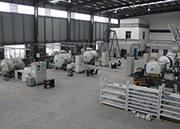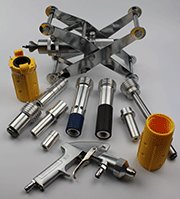E-Archive
Interview
in Vol. 18 - September Issue - Year 2017
The Next Generation Silicon Carbide Nozzle

Serge Weydert, General Manager Europe, HMT

HMT manufacturing facilities in Changsha, PRC

HMT selected standard nozzle products
Hard Materials Technologies (HMT) has been founded in 2016 as a wholly-owned global commercial representation of Shanghai XiangRong Industries (SXR), a manufacturer of products based on hard materials like tungsten carbide, silicon carbide and boron carbide. SXR started operations in 2009 with the manufacturing and trading of a comprehensive range of nozzles for sandblasting and shot peening applications, focusing on boron carbide, silicon carbide and tungsten carbide, manufactured in its facility in Changsha, Central China. Over the years, the success of SXR products lead to the expansion of the product offering into the defense, oil & gas, and general machining industries. In order to satisfy increased customer demand worldwide, an additional production plant, located in Quzhou near Shanghai, has been commissioned Q3 2017. Right now, the group counts 127 employees and generates a consolidated turnover of 16m USD with customers in 27 countries.
(?) MFN: Mr. Weydert, thank you for taking the time to do this interview. Could you please give a brief introduction about yourself and your position within HMT?
(!) S. W.: Before joining HMT, I was, for 16 years, responsible in sales, distribution management and product management for technical ceramics and heavy machinery in the packaging, surface technology and oil&gas industries, with a heavy focus on Asia, where I lived from 2004-2016. I am the general manager of HMT, taking care of commercial operations, service and product management, with emphasis on the EMEA region.
(?) MFN: How is HMT globally present?
(!) S. W.: SXR, in its beginnings, has naturally first concentrated on the APAC region, where our products have already been marketed for 10 years, with the main markets being China, Malaysia, Thailand and Australia. During this time, a few selected accounts in Germany and France were developed remotely. Right now, HMT has managed to establish a vast customer base and distribution network throughout 11 countries in Europe. Next steps will be the Americas as well as the Middle East regions.
(?) MFN: I understand you’ve worked in many different countries?
(!) S. W.: I’ve lived in six different countries and run sales and product management operations all over the world. I thus have had the opportunity to learn a great deal about various ways of making business, the challenges of gathering state-of-the-art market intelligence and technical service requirements in the different regions globally.
(?) MFN: What do you want to accomplish in the next ten years with HMT?
(!) S. W.: Our strategy for the next ten years can be summarized in 3 points: first, the commercial intensifying and strengthening of our actual presence in Europe, which includes, for our complete product portfolio, an increased customer base and a pan-European distribution network. Secondly, the expansion of our presence to the Americas, thus completing our global presence. In parallel, it is a necessity to implement a comprehensive product management program, in order to make sure that the voice of the EMEA and Americas customers are heard and their inputs find their way into our products and solutions offerings. Additionally, the product management, a department which is usually non-existent in small- and medium-sized companies, will be a strategic imperative for HMT/SXR to grow, since it is mandatory to extend our product portfolio over the next years into other industry sectors to achieve above-average growth. I want HMT/SXR to be a global company, exploring new markets and providing our partners with state-of-the-art solutions.
(?) MFN: What are the key products of HMT/SXR?
(!) S. W.: Primarily, HMT/SXR is rather a material solutions supplier than a product supplier. Our range of materials includes boron carbide, silicon carbide and tungsten carbide, with any imaginable composite thereof. Based on the vast material understanding and solution-providing expertise we acquired over the years, we are now able to better partner with our customers to suggest and put into production reliable and economic product solutions. In terms of industries, our key sectors are blasting technology, defense and oil&gas sectors as well as mechanical industries.
(?) MFN: One of the issues which is striking when looking at your product portfolio is that you supply silicon carbide nozzles as an economical alternative to tungsten carbide.
(!) S. W.: Indeed, this is our major differentiation aspect compared to our global competitors. While the common market mindset is that tungsten carbide is the most economic nozzle material followed by silicon carbide with boron carbide being the most expensive (and also most performant), silicon carbide nozzles offer the most economical solutions in HMT's blast technology product range. This is solely due to our matured production process, which turns out to provide silicon carbide nozzles cheaper and more performant than any available high-grade tungsten carbide nozzle.
(?) MFN: How about the customer mindset when it comes to this "revolutionary" silicon carbide?
(!) S. W.: This is a good question indeed. I can confirm that changing the customer mindset with regard to our silicon carbide products is challenging. Nevertheless, you have to respect the customer's requirements/habits; that's why we follow a 2-way marketing here. While several customers directly opt for silicon carbide nozzles due to their performance, weight and price, other customers continue to source our tungsten carbide solutions, while running application tests. Both ways are legitimate. Happily, in the end, the result has, to now, been the same, i.e. there was a switch from tungsten carbide to silicon carbide.
(?) MFN: How about the boron carbide nozzles in your product portfolio?
(!) S. W.: Our boron carbide nozzles are the state-of-the-art. Furthermore, even here, we are able to offer economical solutions. Additionally, since the market for boron carbide nozzles is comparatively lower, the customer can benefit from our mature production process, which allows us to produce small lot sizes of custom-design nozzles at affordable prices.
(?) MFN: From where do the innovation initiatives come?
(!) S. W.: Innovation primarily comes from our customers. We experience this on a daily basis in the nozzle business, where half of our products are small lot special designs. This has pushed both F&E and production to come up with new product designs and innovative production technologies respectively, which to some extent have also become beneficial for our standard product range. Our sales teams ability to discuss on a high technical level with nozzle users allows us to get to know their problems and challenges, which subsequently leads us to suggest viable solutions to them.
(?) MFN: In regard to your product management strategy for the future, will you stay confined to the above-mentioned materials?
(!) S. W.: This is a tough one to answer. I think I can surely say that our product management strategy is two-fold: first, the easier part will be to identify and penetrate into the remaining applications and markets for boron carbide and silicon carbide. As you probably know, the applications for both materials are widespread. With their typical properties like wear resistance and hardness being right now beneficial in areas like sandblasting and armor technologies, we are primarily looking into applications where these physical properties are paramount for good performance. In the future, we want to develop products benefiting from the ability of boron carbide to absorb neutrons without forming long-lived radionuclides, by penetrating into existing markets like neutron radiation absorption arising in nuclear power plants, which is a pretty logical thing to do given the number of nuclear power plants being built in China right now. Nuclear applications of boron carbide include shielding, control rod and shut down pellets. In the field of silicon carbide, we are starting to supply wear and abrasive parts already.
Second to this, we are planning to commercially benefit from our extensive raw materials preparation and blending know-how to supply both boron and silicon carbide powders to other ceramics companies which at present outsource their raw materials.
Medium term outlook for HMT/SXR is to become a global supplier of non-oxide ceramics, since this is the field in which we have been operating all along. We are currently evaluating potentials in several non-oxide ceramics markets, but I can't, at present, tell you more about this.
MFN would like to thank Serge Weydert for this interview!
For Information:
HMT GmbH
7, rue du Marche
9260 Diekirch, Luxembourg
Tel. +352.691.968 613
E-mail: weydert.s@hmt-cera.com
www.hmt-cera.com



























